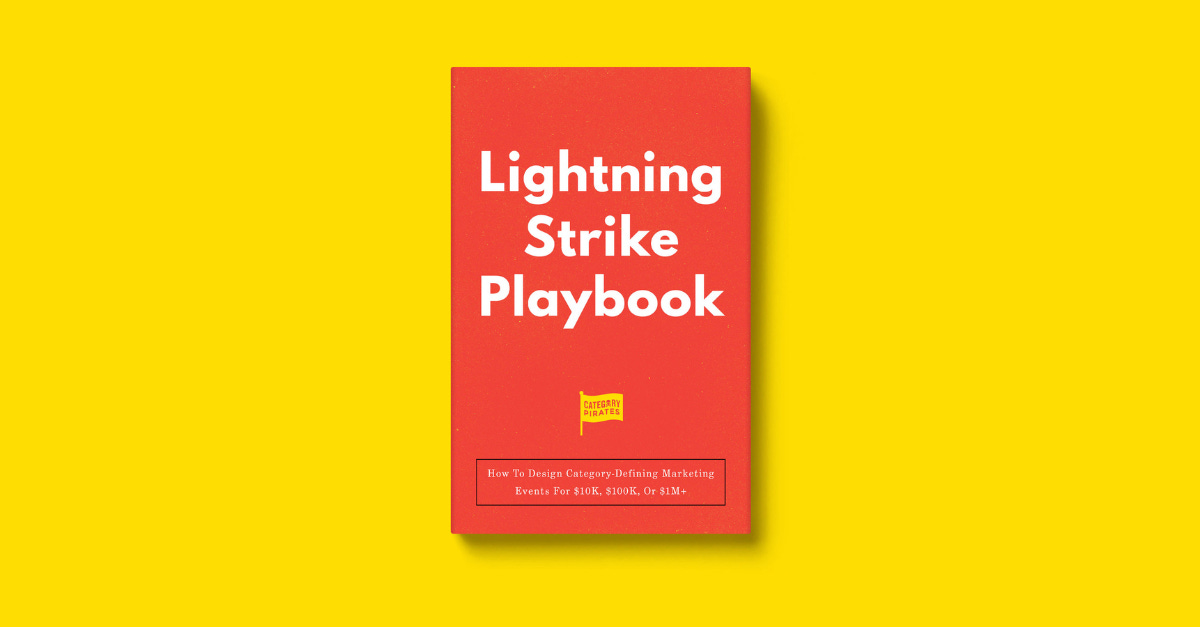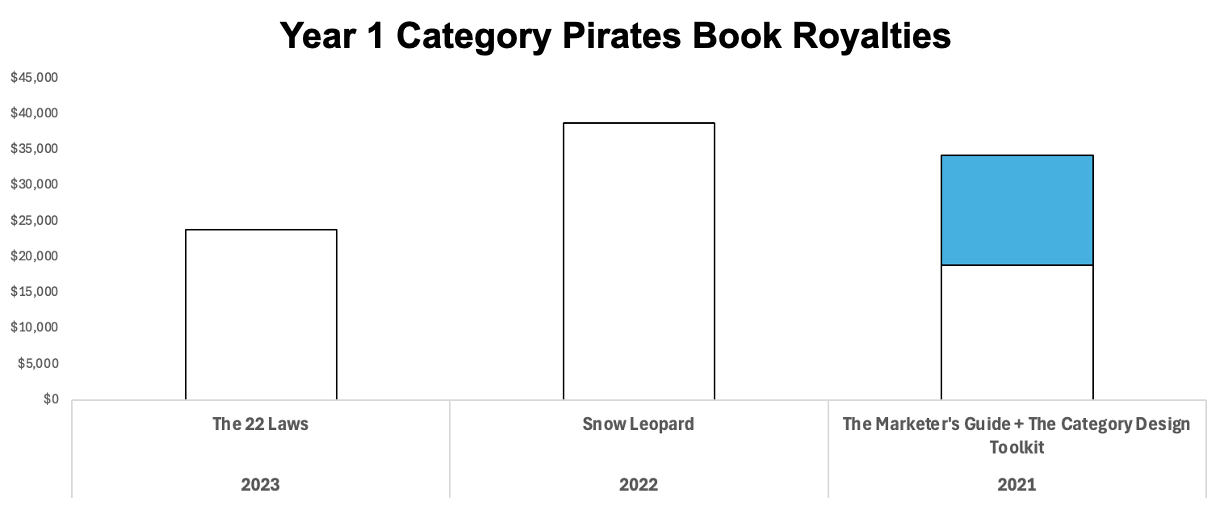Lightning Strike Playbook (Part 2): How To Design Category-Defining Marketing Events For $10K, $100K, Or $1M+
You don’t need millions to run a strike that moves the market.
Arrrrr! 🏴☠️ Welcome to a 🔒 subscriber-only edition 🔒 of Category Pirates. Each week, we share radically different ideas to help you design new and different categories. For more: Dive into an audiobook, listen to a category design jam session, or upgrade to a Founding subscription to ask the Pirate Eddie Bot your category design questions.
Dear Friend, Subscriber, and Category Pirate,
Last week in The Lightning Strike Playbook mini-book, we broke down the 5 types of category-defining strikes—and how each drives word-of-mouth, belief, and revenue.
The Stunt Strike – Capture attention and win Supers fast
The Fight Strike – Design a new game
The Scarcity Strike – Elevate perceived value + trigger FOMO
The Functional Strike – Scale belief through education or transformation
The Culture Creating Strike – Elevate above a business, to a beloved friend
Now, it’s time to break down the budget.
In this mini-book, we’ll show you what strikes look like when they’re free and when you spend 4-figures, 5-figures, 6-figures, and 7-figures. You’ll see real-world examples and get suggestions for each budget tier. And at the end, you’ll get a simple framework for following and amplifying your Lightning Strike’s chain of events.
Let’s dive in. ⚡⚡⚡
How To Budget A Lightning Strike From $1,000 To $1,000,000+
First, a quick public service announcement.
The success of your strike is not directly correlated to the size of your budget. It’s about what you can do with the resources you have. You don’t have to outspend incumbents. You just have to out-think and out-execute them.
In Lightning Strikes, brains beat bucks.
The right strike, targeted at the right Superconsumers, with the right POV, to drive the right word of mouth (WOM) can bend the universe. You can do any type of strikes—Stunt, Fight, Scarcity, Functional, or Culture—at any budget level.
Success is about the clarity of your outcome, the power of your POV, and the courage of your execution.
If you’re a startup or smaller company, you have three massive advantages:
You have speed. You can decide right now and execute right now. The CEO of GM can’t do that.
You can take risks big companies can’t. The CEO of DUDE Wipes can post a picture of a meeting room at their headquarters called “The Fart Room.” The CEO of Kimberly-Clark can’t do that.
You do not have a revenue prevention department. The bigger and more complex a company gets, the more saying “no” is valued. So legendary ideas can get crushed before someone with the power to green-light them even hears them. When Pirate Christopher was in his early 30s, a wise friend and mentor named Nick DiGiacomo reminded him, “Big companies are conservative because they have something to conserve.”
Regardless of the budget, you must have a plausible plan to break even or make money on the Lightning Strike. A plan your CFO can say with a straight face to the CEO, the board of directors, and key investors.
Your Lightning Strike must deliver:
Revenue, both now and in the future
A credible flywheel of leads, conversations, conversions, and margin directly from the strike
A clear increase in usage, spending, and LTV by current customers who are part of the strike
(Note: We didn’t say any marketing mumbo jumbo about impressions or brand value.)
Marketing that doesn’t drive revenue is called arts and crafts. A Lightning Strike that doesn’t more than pay for itself is called sparks and crafts.
This next section will help you right-size the ambition to the moment.
Let’s break down what’s possible.
$0 Lightning Strikes: Be Radically Generous With Superconsumers
You don’t need millions to run a strike that moves the market.
If you’ve got a point of view, a list of Supers, and something worth talking about, you can pull off a Lightning Strike for zero dollars. For instance, our big books have been an interesting $0 strike category science experiment.
Here are the Year 1 book royalties for our top 3 books:
Each year represents different strategies.
In 2021, we focused on volume and shots on goal. We launched two books, The Category Design Toolkit and The Marketer’s Guide to Category Design, with no paid advertising.
In 2022, we launched Snow Leopard with a few hundred dollars of Amazon ads, a few thousand dollars on paid media via book influencers, and a Superconsumer lightning strike.
In 2023, we launched The 22 Laws of Category Design with no paid advertising and Superconsumer lightning strikes.
At face value, it looks like the paid advertising worked for Snow Leopard with a near 4x ROI. But the mini-books that went into Snow Leopard remain some of our most popular ever in our Substack, so it’s not clear the incremental $15,000 was due to the advertising. It also appears that volume and shots on goal matter, as two big books launched in 2021 brought in nearly as much as Snow Leopard.
The takeaways:
Marketing works, but scale matters. Books are subscale products that don’t really allow enough advertising to work. Steady marketing also helps, because it helps you build relationships with your readers to improve your marketing.
Volume works, but it costs time. We published two books in 2021. When we first launched Category Pirates, we published a new mini-book every week (which was unsustainable).
Radical generosity with Supers always works. So if your product/category is subscale for paid advertising and time is a constraint, always default to being radically generous with Supers. It costs you nothing and is a sure ROI.
The key is to collaborate with your Superconsumers, not strangers.
Too many marketers blow their small budget chasing cold impressions. But the people most likely to move your market are the ones already leaning in—your best customers, readers, followers, alumni, or fans.
When we launched Snow Leopard, we spent about $10,000 on influencer outreach and Amazon ads.
We targeted creators and book reviewers in our network (and one degree away).
We gave them media kits, copy, and custom assets so posting was easy.
We followed up to make sure the post hit during launch week.
That $10K turned into $50K in book sales, plus a long tail of new subscribers.
But we also ran a live launch event designed to turn our most engaged readers into an army of co-marketers. Here’s how we framed it:
To celebrate the launch of our new book Snow Leopard, we’d like to invite you to a special live event this Friday at 9am ET.
The 3 of us will be answering questions from attendees, and discussing:
The Content Pyramid
Obvious vs Non-Obvious Content
Direct-To-Creator Business Models
The Power Of A POV (And Using Languaging!)
How To “Niche Down” & Create Your Own Category
To join us for this special event, all you have to do is:
Step 1: Buy the eBook or print book on Amazon.
Step 2: Email us a screenshot of your receipt.
Step 3: Include 1–3 questions you’d like us to answer during the live session.
We’ll send you the Zoom link once we’ve got your receipt.
We didn’t host this webinar just to sell books. It was also about:
Making the offer feel insider (limited to people who had already bought)
Crowdsourcing participation (attendees submitted their own questions)
Turning a transaction into a relationship (buyers became live event participants)
Creating urgency (“We’ll send out Zoom invites tomorrow, grab your seat now.”)
The result: That event and $10K spent turned into $50K in book sales—plus new subscribers, consulting inquiries, and an enduring “I was there” moment for our Supers.




